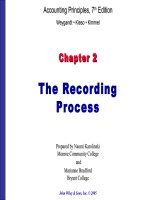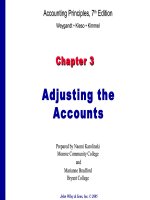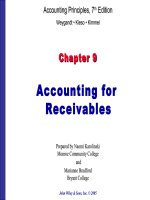Accounting principles 7th kieso kimel chapter 02
Bạn đang xem bản rút gọn của tài liệu. Xem và tải ngay bản đầy đủ của tài liệu tại đây (2.31 MB, 68 trang )
Accounting Principles, 7th Edition
Weygandt • Kieso • Kimmel
Chapter 2
The Recording
Process
Prepared by Naomi Karolinski
Monroe Community College
and
Marianne Bradford
Bryant College
John Wiley & Sons, Inc. © 2005
CHAPTER 2
THE RECORDING
After studying this
chapter, you should be able to:
PROCESS
1 Explain what an account is and how it
helps in the recording process
2 Define debits and credits and explain
how they are used to record business
transactions
3 Identify the basic steps in the
recording process
4 Explain what a journal is and how it
helps in the recording process
CHAPTER 2
THE RECORDING
After studying PROCESS
this chapter, you should be able to:
5 Explain what a ledger is and how it
helps in the recording process
6 Explain what posting is and how it helps
in the recording process
7 Prepare a trial balance and explain its
purpose
THE ACCOUNT
STUDY OBJECTIVE 1
• An account is an individual
accounting record of increases
and decreases in a specific asset,
liability, or owner’s equity item.
• There are separate accounts for
the items we used in transactions
such as cash, salaries expense,
accounts payable, etc.
BASIC FORM OF ACCOUNT
STUDY OBJECTIVE 2
• The simplest form an account consists of
1 the title of the account
2 a left or debit side
3 a right or credit side
• The alignment of these parts resembles the
letter T = T account
Title of Account
Left or debit side
Right or credit side
Debit balance
Credit balance
DEBITS AND
CREDITS
• Debit indicates left and Credit indicates right
• Recording $ on the left side of an account is
debiting the account
• Recording $ on the right side is crediting the
account
• If the total of debit amounts is bigger than
credits, the account has a debit balance
• If the total of credit amounts is bigger than
debits, the account has a credit balance
TABULAR SUMMARY
COMPARED TO ACCOUNT
FORM
DEBITING AN
ACCOUNT
Cash
Debits
Credits
15,000
Example:
Example: The
Theowner
ownermakes
makesan
aninitial
initial
investment
investment of
of$15,000
$15,000to
to start
start
the
thebusiness.
business. Cash
Cashis
isdebited
debited
as
asthe
the owner’s
owner’sCapital
Capitalis
is
credited.
credited.
CREDITING AN
ACCOUNT
Cash
Debits
Credits
7,000
Example:
Example: Monthly
Monthlyrent
rentof
of $7,000
$7,000 is
ispaid.
paid.
Cash
Cashis
iscredited
creditedas
as Rent
Rent
Expense
Expense is
isdebited.
debited.
DEBITING / CREDITING
AN ACCOUNT
Cash
Debits
15,000
Credits
7,000
8,000
Example:
Example: Cash
Cashis
is debited
debited for
for $15,000
$15,000
and
and credited
creditedfor
for $7,000,
$7,000,leaving
leaving
aadebit
debit balance
balance of
of $8,000.
$8,000.
DOUBLE-ENTRY
SYSTEM
• equal debits and credits made
accounts for each transaction
• total debits always equal the total
credits
• accounting equation always stays
in balance
Assets
Liabilities
Equity
DEBIT AND CREDIT EFFECTS
— ASSETS AND LIABILITIES
Debits
Increase assets
Credits
Decrease assets
Decrease liabilities Increase liabilities
NORMAL BALANCE
• every account has a
designated normal balance.
– It is either a debit or credit.
• accounts rarely have an
abnormal balance.
NORMAL BALANCES —
ASSETS AND LIABILITIES
Assets
Increase
•Normal
Decrease
Balance
Liabilities
Debit
Decrease
Increase
Credit
Normal
Balance
DEBIT AND CREDIT EFFECTS
— OWNER’S CAPITAL
Debits
Decrease owner’s capital
Credits
Increase owner’s capital
NORMAL BALANCE — OWNER’S
CAPITAL
Owner’s Capital
Decrease
Increase
Normal
DebitBalance
Credit
DEBIT AND CREDIT EFFECTS
— OWNER’S DRAWING
Debits
Increase owner’s drawing
Credits
Decrease owner’s
drawing
Remember,
Remember,Drawing
Drawingisisaacontra-account
contra-account––an
anaccount
accountthat
thatisis
backwards
backwardsfrom
fromthe
theaccount
accountititaccompanies
accompanies(the
(theCapital
Capital
account).
account).
NORMAL BALANCE —
OWNER’S DRAWING
Owner’s Drawing
Increase
Normal
Balance
Credit
Decrease
Debit
DEBIT AND CREDIT EFFECTS
— REVENUES AND EXPENSES
Debits
Decrease revenues
Increase expenses
Credits
Increase revenues
Decrease expenses
NORMAL
REVENUES
BALANCES —
AND EXPENSES
Revenues
Decrease
Increase
Normal
Balance
Expenses
IncreaseDebit
Decrease
Credit
Normal
Balance
EXPANDED BASIC EQUATION
AND DEBIT/CREDIT RULES
AND EFFECTS
Assets
Assets
Dr.
+
Cr.
-
= Liabilities
=
Liabilities
Dr.
-
Owner’s Equity
+
+
Cr.
+
Owner’s
Capital
Dr.
-
+
Cr.
+
Revenues
Dr.
-
-
Cr.
+
Owner’s
Drawing
Dr.
+
-
Cr.
-
Expenses
Dr.
+
Cr.
-
Which of the following is not true of the
terms debit and credit.
a. They can be abbreviated as Dr. and Cr.
b. They can be interpreted to mean increase and
decrease.
c. They can be used to describe the balance of an
account.
d. They can be interpreted to mean left and right.
Chapter 2
Which of the following is not true of the
terms debit and credit.
a. They can be abbreviated as Dr. and Cr.
b. They can be interpreted to mean increase and
decrease.
c. They can be used to describe the balance of an
account.
d. They can be interpreted to mean left and right.
Chapter 2
THE RECORDING
PROCESS
STUDY OBJECTIVE 3
1 analyze each transaction (+, -)
2 enter transaction in a journal
3 transfer journal information to
ledger accounts
THE JOURNAL
STUDY OBJECTIVE 4
• Transactions
– Are initially recorded in chronological
order before they are transferred to the
ledger accounts.
• A general journal has
1 spaces for dates
2 account titles and explanations
3 references
4 two amount columns









